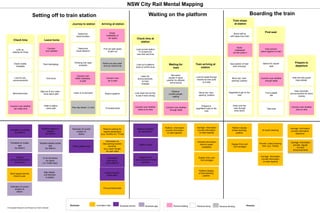
NSW City Rail Model Model
- 1. NSW City Rail Mental Mapping Boarding the train Waiting on the platform Setting off to train station Train stops at station Journey to station Arriving at station Brace self aswild blows from train Determine travel duration Check availability of car space Find seat Check time atstation Check time Leave home Concern over weather Determinetravel distance Find car park space& park car Noise unpleasant as train pulls in Feel concern about hygiene on train Look up website for times Look up train stationTV screens for next train and time Thinking over daysschedule Pack belongings Notice car park peak time as mental note Search for vacant seat Check mobile timetable See position of trainentry doorway Look up to platformclock to confirm time Prepare to departure Train arriving at station Waiting for train Exit home Concern overtraffic/ obstacles to path Hear the train guardblow whistle See same people in sameposition for efficientexit at arrival Look for any announcements Concern overcar in park Move into “door opening” position Concern over whetherenough seats Look for seats throughwindow as train pullsto a stop Listen for announcements for train changes Start car & turn radio – drive same path Listen to music/radio Memorise times Hear automatic announcement for doorsclosing Walk to platform Negotiate to get on the train Move into “door opening” position Observe number people waiting Find suitablesite Look down the rail line to see if train coming Walk to station same path Concern over whethercan make time Plan day ahead in mind Enter onto the train throughentry doors Purchase ticket Concern over whethertrain on time Concern over whethertrains is on-time Prepare to negotiate to get on the train Take seat Concern over whetherenough seats Carriage informationprovide informationon seat capacity Air scent cleaning Platform timetable (by destination) Platform informationprovide informationon seat capacity Platform displayof best standing position Carriage informationprovide informationdeparture Timetable on website(by station) Weather details on website(by station) Estimator of currentlocation tostation Reserve parking forregular passengers(e.g. monthly incl . Price) Onboard informationdirect to seats availability Provide ‘Latest cleaningtime’ (e.g. Toilets) Platform clock Display Entry and Exit carriages Timetable on mobile app(by station) Weather details mobileapp(by station) Traffic update news Information onbest parking locationand time (e.g. mash Googlecar park data) Carriage informationprovide regular ‘on-time’ announcements Display Entry and Exit carriages Carriage informationprovide informationon seat capacity Specialannouncement/news(by station) Regular train announcement of nextservices To do list beforeyou leave(i.e. mobile app) Informationsafe way to enter platform Platform displayof best standing position Vendor/ Human ticket sales Send regular servicetimes to user Map details and directionto station Pre-purchase ticket Estimator of currentlocation tostation Innovation idea Business Persona Business priority Business gap Persona feeling Persona doing Persona thinking © Copyright Research and Prepare by Franki Chamaki
- 2. NSW City Rail Mental Mapping Background So, how was this Mental Model created? The Mental Model * focuses on the passenger journey from origin (i.e. getting out of the home) right up to boarding the train. The scope of the modelling was done in this way to allow myself to ‘deep drive’ and really understand the problem from a passenger perspective and to address the problem statement: How can City Rail effectively manage ‘overcrowding’ on its rail system? The Model Mental data is based on real life contextual inquiry (ie ethnographic investigation) with actual passengers on the NSW City Rail system during a course of 1 month in late January 2010. Contextual inquires involve both observational and interview style. Passenger feelings, thoughts and actions were recorded and tag against the ‘Task’ and ‘Type of Task’ (see “Transcript Analysis” below) in order to begin the construction of the Mental Model. At the same time, specific task based audience segments started to emerge. These included: the ‘Travel challenged’, the ‘Concern traveller’ and the ‘9 to 5 worker’ traveller etc. With further affinity analysis, these ‘archetypes’ synthesised into three (3) priority segments (ie segments that NSW City Rail should really focus (i.e. apply Pareto principle of the 80% rule)), namely the “Concerned Traveller” (the traveller that is always concerned about hygiene, safely, sanitation, security on our rail system), “Travel challenged” (this is the traveller that tends to be those “loaded” while travelling – luggage to the airport, parents with prams, disability or elderly people) and the last priority segment: “Need to Be On time’ traveller (i.e. your office worker, your 9 to 5 worker, the traveller who really need to be there at a specific time to meet an appointment such as doctors, dinner with friends etc). I later took these three (3) priority segments and created ‘personas’ in order to build real empathy and help me understand their concerns, feelings and view point to enable me to develop viable, feasibile and desirable ideas to help NSW CityRail and its passenagers overcome overcrowding and related concerns. Persona phase/step Mental space Detail list of persona ‘Tasks’(i.e. do, think, feel) Task based audience segmentation analysis Possible business ways to support it Page 2 of 11 Persona& Business Legend Contextual enquires Affinity Brainstorm Transcript analysis *Note: this is self-project not requested or commissioned by anyone. I had enough of overcrowding and took on the challenge to see if I can do something about it. I love the NSW CityRail system both from environment and economic perspective but I just wish it worked better for our Sydney commuters, © Copyright Research and Prepare by Franki Chamaki
